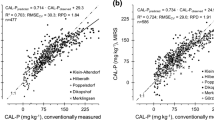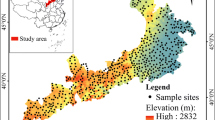Abstract
Adjusting fertiliser applications to within-field variations in nitrogen (N) mineralisation during the growing season can increase yields, improve crop quality, reduce costs and decrease nutrient losses to the environment. Predicting such variations at a reasonable cost is therefore important. In a 3-year study, Near Infrared Reflectance (NIR) spectroscopy was compared with soil organic matter (SOM) and clay content as predictors of plant N uptake using cross-validated PLS (Partial Least Squares) regression models. Plant N uptake was measured as total nitrogen in aboveground plant parts at harvest, in plots without N fertilisation within three different fields in southern Sweden. NIR spectroscopy and combined clay and SOM content resulted in equally good estimations of plant N uptake in fields with large variation in SOM content. Cross-validated NIR calibrations for plant N uptake within fields for separate years resulted in r 2 values of 0.75–0.85 and average cross-validation errors of 11–16 kg N ha−1 for two fields (1 year excluded at one field because of farmyard manure application). No significant improvements were seen when NIR-spectra, clay and SOM were included in the same model, suggesting that the additional predictive capacity of NIR over SOM relates to soil texture variations. NIR calibrations also performed poorly in one field where plant N uptake could not be explained by SOM or clay content. Predictions within fields between years produced r 2 values of 0.56–0.89 and prediction errors of 12–26 kg N ha−1 for one field. These results confirm that N uptake prediction accuracy can be improved by using NIR spectroscopy in fields with large SOM variations. However, good estimations could not be made between fields, indicating difficulties in creating more general calibration models for large geographical areas.



Similar content being viewed by others
References
Alexandersson H, Eggertsson Karlström C L-M (2001) Temperaturen och nederbörden i Sverige 1961–1990. Referensnormaler – utgåva 2. pp 71. SMHI, Norrköping
Barnes RJ, Dhanoa MS, Lister SJ (1989) Standard normal variate transformation and de-trending of near-infrared diffuse reflectance spectra. Appl Spectrosc 43:772–777
Ben-Dor E, Banin A (1995a) Near-infrared analysis as a rapid method to simultaneously evaluate several soil properties. Soil Sci Soc Am J 59:364–372
Ben-Dor E, Banin A (1995b) Near-infrared analysis (NIRA) as a method to simultaneously evaluate spectral featureless constituents in soils.. Soil Sci 159:259–270
Borggaard C (2001) Neural networks in near-infrared spectroscopy. In: Williams P, Norris K (eds) Near-infrared technology in the agricultural and food industries, 2nd ed. American Association of Cereal Chemists, St. Paul, MN, pp 101–107
Börjesson T, Stenberg B, Linden B, Jonsson A (1999) NIR spectroscopy, mineral nitrogen analysis and soil incubations for the prediction of crop uptake of nitrogen during the growing season. Plant Soil 214:75–83
Chang CW, Laird DA, Mausbach MJ, Hurburgh CR (2001) Near-infrared reflectance spectroscopy-principal components regression analyses of soil properties. Soil Sci Soc Am J 65:480–490
Cozzolino D, Moron A (2006) Potential of near-infrared reflectance spectroscopy and chemometrics to predict soil organic carbon fractions. Soil Tillage Res 85:78–85
Delin S, Lindén B (2002) Relations between net nitrogen mineralization and soil characteristics within an arable field. Acta Agric Scand Sect B – Soil Plant Sci 52:78–85
Dunn B, Beecher G, Batten G, Blakeney A (2000) Estimating the uptake of nitrogen by rice crops using near infrared reflectance analysis of soil.. In: Davies AMC, Giangiacomo R (eds) Near infrared spectroscopy. Proceedings of the 9th International Conference, Verona, Italy, pp 565–568
Ekström G (1927) Klassifikation av Svenska Åkerjordar (Classification of Swedish Arable Soils). Sveriges Geologiska Undersökning, Ser C. No. 345 (Årsbok 20) pp 161
Fox RH, Shenk JS, Piekielek WP, Westerhaus MO, Toth JD, Macneal KE (1993) Comparison of near-infrared spectroscopy and other soil nitrogen availability quick tests for corn. Agronomy Journal 85:1049–1053
Fystro G (2002) The prediction of C and N content and their potential mineralisation in heterogeneous soil samples using Vis-NIR spectroscopy and comparative methods. Plant Soil 246:139–149
Gee GW, Bauder JW (1986) Particle-size analysis. In: Klute A (ed) Physical and mineralogical methods. Soil Science Society of America, Madison, pp 383–411
Hartmann HP, Appel T (2006) Calibration of near infrared spectra for measuring decomposing cellulose and green manure in soils. Soil Biol Biochem 38:887–897
Islam K, Singh B, McBratney A (2003) Simultaneous estimation of several soil properties by ultra-violet, visible, and near-infrared reflectance spectroscopy. Aust J Soil Res 41:1101–1114
Malley DF, Martin PD, McClintock LM, Yesmin L, Eilers RG, Haluschak P (2000) Feasibility of analysing archived Canadian prairie agricultural soils by near infrared reflectance spectroscopy. In: Davies AMC, Giangiacomo R (eds) Near infrared spectroscopy: Proceedings of the 9th International Conference. NIR Publications, Chichester, UK, pp 579–585
Malley DF, Martin PD, Ben-Dor E (2004) Applications in analysis of soils. In: Roberts CA, Workman J Jr, Reeves JB III (eds) Near-infrared spectroscopy in agriculture. ASA, CSSA, SSSA, Madison, Wisconsin, USA, pp 729–784
Martens H, Naes T (1989) Multivariate Calibration. Wiley, Chichester, UK 419 pp
Mouazen AM, De Baerdemaeker J, Ramon H (2005) Towards development of on-line soil moisture content sensor using a fibre-type NIR spectrophotometer. Soil Tillage Res 80:171–183
Reeves JB, Follett RF, McCarty GW, Kimble JM (2006) Can near or mid-infrared diffuse reflectance spectroscopy be used to determine soil carbon pools? Commun Soil Sci Plant Anal 37:2307–2325
Savitzky A, Golay M (1964) Smoothing and differentiation of data by simplified least squares procedures. Anal Chem 36:1627–1639
Shepherd KD, Walsh MG (2002) Development of reflectance spectral libraries for characterization of soil properties. Soil Sci Soc Am J 66:988–998
Sorensen LK, Dalsgaard S (2005) Determination of clay and other soil properties by near infrared spectroscopy. Soil Sci Soc Am J 69:159–167
Stenberg B, Nordkvist E, Salomonsson L (1995) Use of near infrared reflectance spectra of soils for objective selection of samples. Soil Sci 159:109–114
Stenberg B, Jonsson A, Börjesson T (2002) Near infrared technology for soil analysis with implications for precision agriculture. In: Davies A, Cho R (eds) Near infrared spectroscopy. Proceedings of the 10th International Conference, Kyongju S. Korea, pp 279–284
Stenberg B, Jonsson A, Borjesson T (2005) Use of near infrared reflectance spectroscopy to predict nitrogen uptake by winter wheat within fields with high variability in organic matter. Plant Soil 269:251–258
Terhoeven-Urselmans T, Michel K, Helfrich M, Flessa H, Ludwig B (2006) Near-infrared spectroscopy can predict the composition of organic matter in soil and litter. J Plant Nutr Soil Sci – Z Pflanzenernahr Bodenkd 169:168–174
van Groenigen JW, Mutters CS, Horwath WR, van Kessel C (2003) NIR and DRIFT-MIR spectrometry of soils for predicting soil and crop parameters in a flooded field. Plant Soil 250:155–165
Wetterlind J, Stenberg B, Söderström M (2007a) Farm-soil mapping using NIR-technique for increased sample point density. In: 6th European Conference on Precision Agriculture, Skiathos, Greece, 3–6 June, 2007. Ed JV Stafford pp 265–270
Wetterlind J, Stenberg B, Söderström M (2007b) New strategy for farm-soil mapping using NIR to increase sample point density. In 12th International Conference, Auckland, New Zealand, 2005. Ed RMW Sumner. pp 299–303
Williams PC (1987) Variables affecting near-infrared reflectance spectroscopic analysis. In: Williams P, Norris K (eds) Near-infrared technology in the agricultural and food industries. 1st ed. American Association of Cereal Chemists, St. Paul, MN, pp 143–167
Zadoks JC, Chang TT, Konzak CF (1974) A decimal code for the growth stages of cereals. Weed Research 14:415–421
Acknowledgements
We wish to thank the Swedish Farmers’ Foundation for Agricultural Research (SLF) for funding the work and the farmers Sören Nyman, Mikael Fransén and Jarl Ryberg for putting their fields at our disposal. We also wish to thank Thord Karlsson for valuable collaboration during the planning and execution of the field work.
Author information
Authors and Affiliations
Corresponding author
Additional information
Responsible Editor: Hans Lambers.
Rights and permissions
About this article
Cite this article
Wetterlind, J., Stenberg, B. & Jonsson, A. Near infrared reflectance spectroscopy compared with soil clay and organic matter content for estimating within-field variation in N uptake in cereals. Plant Soil 302, 317–327 (2008). https://doi.org/10.1007/s11104-007-9489-9
Received:
Accepted:
Published:
Issue Date:
DOI: https://doi.org/10.1007/s11104-007-9489-9




